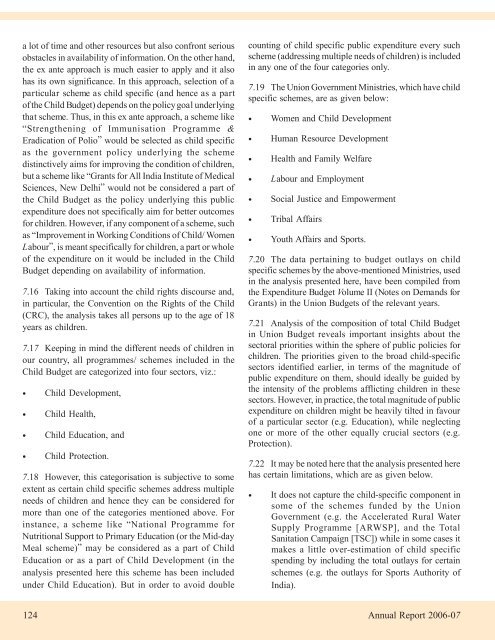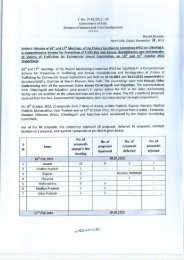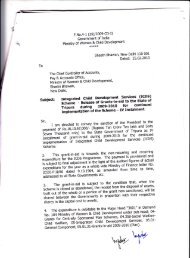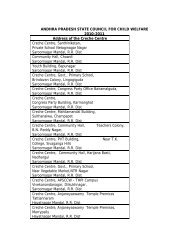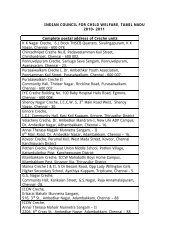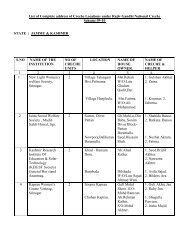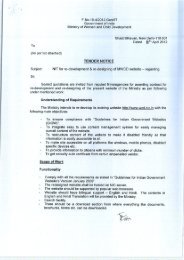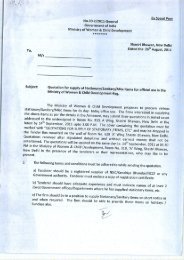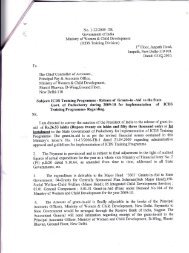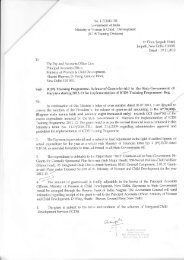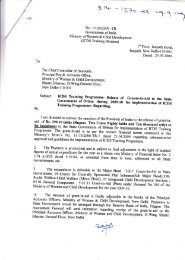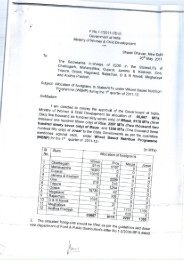COVER HINDI - Ministry of Women and Child Development
COVER HINDI - Ministry of Women and Child Development
COVER HINDI - Ministry of Women and Child Development
- TAGS
- hindi
- ministry
- wcd.nic.in
You also want an ePaper? Increase the reach of your titles
YUMPU automatically turns print PDFs into web optimized ePapers that Google loves.
a lot <strong>of</strong> time <strong>and</strong> other resources but also confront serious<br />
obstacles in availability <strong>of</strong> information. On the other h<strong>and</strong>,<br />
the ex ante approach is much easier to apply <strong>and</strong> it also<br />
has its own significance. In this approach, selection <strong>of</strong> a<br />
particular scheme as child specific (<strong>and</strong> hence as a part<br />
<strong>of</strong> the <strong>Child</strong> Budget) depends on the policy goal underlying<br />
that scheme. Thus, in this ex ante approach, a scheme like<br />
“Strengthening <strong>of</strong> Immunisation Programme &<br />
Eradication <strong>of</strong> Polio” would be selected as child specific<br />
as the government policy underlying the scheme<br />
distinctively aims for improving the condition <strong>of</strong> children,<br />
but a scheme like “Grants for All India Institute <strong>of</strong> Medical<br />
Sciences, New Delhi” would not be considered a part <strong>of</strong><br />
the <strong>Child</strong> Budget as the policy underlying this public<br />
expenditure does not specifically aim for better outcomes<br />
for children. However, if any component <strong>of</strong> a scheme, such<br />
as “Improvement in Working Conditions <strong>of</strong> <strong>Child</strong>/ <strong>Women</strong><br />
Labour”, is meant specifically for children, a part or whole<br />
<strong>of</strong> the expenditure on it would be included in the <strong>Child</strong><br />
Budget depending on availability <strong>of</strong> information.<br />
7.16 Taking into account the child rights discourse <strong>and</strong>,<br />
in particular, the Convention on the Rights <strong>of</strong> the <strong>Child</strong><br />
(CRC), the analysis takes all persons up to the age <strong>of</strong> 18<br />
years as children.<br />
7.17 Keeping in mind the different needs <strong>of</strong> children in<br />
our country, all programmes/ schemes included in the<br />
<strong>Child</strong> Budget are categorized into four sectors, viz.:<br />
— <strong>Child</strong> <strong>Development</strong>,<br />
— <strong>Child</strong> Health,<br />
— <strong>Child</strong> Education, <strong>and</strong><br />
— <strong>Child</strong> Protection.<br />
7.18 However, this categorisation is subjective to some<br />
extent as certain child specific schemes address multiple<br />
needs <strong>of</strong> children <strong>and</strong> hence they can be considered for<br />
more than one <strong>of</strong> the categories mentioned above. For<br />
instance, a scheme like “National Programme for<br />
Nutritional Support to Primary Education (or the Mid-day<br />
Meal scheme)” may be considered as a part <strong>of</strong> <strong>Child</strong><br />
Education or as a part <strong>of</strong> <strong>Child</strong> <strong>Development</strong> (in the<br />
analysis presented here this scheme has been included<br />
under <strong>Child</strong> Education). But in order to avoid double<br />
counting <strong>of</strong> child specific public expenditure every such<br />
scheme (addressing multiple needs <strong>of</strong> children) is included<br />
in any one <strong>of</strong> the four categories only.<br />
7.19 The Union Government Ministries, which have child<br />
specific schemes, are as given below:<br />
— <strong>Women</strong> <strong>and</strong> <strong>Child</strong> <strong>Development</strong><br />
— Human Resource <strong>Development</strong><br />
— Health <strong>and</strong> Family Welfare<br />
— Labour <strong>and</strong> Employment<br />
— Social Justice <strong>and</strong> Empowerment<br />
— Tribal Affairs<br />
— Youth Affairs <strong>and</strong> Sports.<br />
7.20 The data pertaining to budget outlays on child<br />
specific schemes by the above-mentioned Ministries, used<br />
in the analysis presented here, have been compiled from<br />
the Expenditure Budget Volume II (Notes on Dem<strong>and</strong>s for<br />
Grants) in the Union Budgets <strong>of</strong> the relevant years.<br />
7.21 Analysis <strong>of</strong> the composition <strong>of</strong> total <strong>Child</strong> Budget<br />
in Union Budget reveals important insights about the<br />
sectoral priorities within the sphere <strong>of</strong> public policies for<br />
children. The priorities given to the broad child-specific<br />
sectors identified earlier, in terms <strong>of</strong> the magnitude <strong>of</strong><br />
public expenditure on them, should ideally be guided by<br />
the intensity <strong>of</strong> the problems afflicting children in these<br />
sectors. However, in practice, the total magnitude <strong>of</strong> public<br />
expenditure on children might be heavily tilted in favour<br />
<strong>of</strong> a particular sector (e.g. Education), while neglecting<br />
one or more <strong>of</strong> the other equally crucial sectors (e.g.<br />
Protection).<br />
7.22 It may be noted here that the analysis presented here<br />
has certain limitations, which are as given below.<br />
— It does not capture the child-specific component in<br />
some <strong>of</strong> the schemes funded by the Union<br />
Government (e.g. the Accelerated Rural Water<br />
Supply Programme [ARWSP], <strong>and</strong> the Total<br />
Sanitation Campaign [TSC]) while in some cases it<br />
makes a little over-estimation <strong>of</strong> child specific<br />
spending by including the total outlays for certain<br />
schemes (e.g. the outlays for Sports Authority <strong>of</strong><br />
India).<br />
124 Annual Report 2006-07


